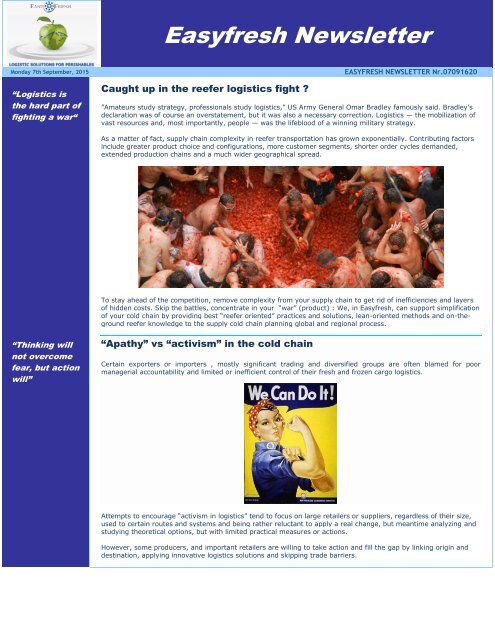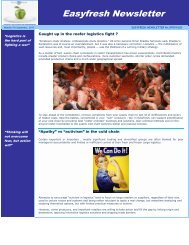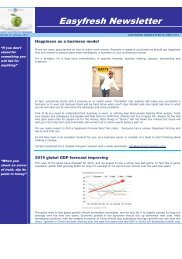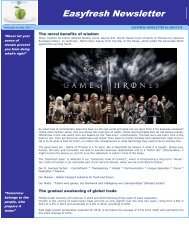Easyfresh Newsletter 07091520.pdf
- No tags were found...
Create successful ePaper yourself
Turn your PDF publications into a flip-book with our unique Google optimized e-Paper software.
<strong>Easyfresh</strong> <strong>Newsletter</strong><br />
Monday 7th September, 2015<br />
“Logistics is<br />
the hard part of<br />
fighting a war“<br />
Caught up in the reefer logistics fight ?<br />
EASYFRESH NEWSLETTER Nr.07091620<br />
”Amateurs study strategy, professionals study logistics,” US Army General Omar Bradley famously said. Bradley’s<br />
declaration was of course an overstatement, but it was also a necessary correction. Logistics — the mobilization of<br />
vast resources and, most importantly, people — was the lifeblood of a winning military strategy.<br />
As a matter of fact, supply chain complexity in reefer transportation has grown exponentially. Contributing factors<br />
include greater product choice and configurations, more customer segments, shorter order cycles demanded,<br />
extended production chains and a much wider geographical spread.<br />
To stay ahead of the competition, remove complexity from your supply chain to get rid of inefficiencies and layers<br />
of hidden costs. Skip the battles, concentrate in your “war” (product) : We, in <strong>Easyfresh</strong>, can support simplification<br />
of your cold chain by providing best “reefer oriented” practices and solutions, lean-oriented methods and on-theground<br />
reefer knowledge to the supply cold chain planning global and regional process.<br />
“Thinking will<br />
not overcome<br />
fear, but action<br />
will”<br />
“Apathy” vs “activism” in the cold chain<br />
Certain exporters or importers , mostly significant trading and diversified groups are often blamed for poor<br />
managerial accountability and limited or inefficient control of their fresh and frozen cargo logistics.<br />
Attempts to encourage “activism in logistics” tend to focus on large retailers or suppliers, regardless of their size,<br />
used to certain routes and systems and being rather reluctant to apply a real change, but meantime analyzing and<br />
studying theoretical options, but with limited practical measures or actions.<br />
However, some producers, and important retailers are willing to take action and fill the gap by linking origin and<br />
destination, applying innovative logistics solutions and skipping trade barriers.
“Seek your<br />
connection and<br />
stay<br />
connected”<br />
Key determinants of container shipping, port and country connectivity<br />
The position of a port or a country within the global liner shipping industry is very dependant on following factors:<br />
Its geographical position, its captive or local cargo flows, its port facilities and the legal framework for liner<br />
shipping:<br />
Geographical position : Lying close to the main shipping routes or next to a large trading nation makes it easier for<br />
a port to attract liner companies and become a port of call. The Caribbean islands, for example, are closer to the<br />
main East–West and North–South routes than most SIDS in<br />
the Indian Ocean or the Pacific.<br />
Port characteristics : Shipping lines will be more inclined to connect a country’s ports to their global liner network if<br />
they can rely on modern infrastructure and efficient operations.<br />
This issue is also closely linked to the determinants of various transport cost. If the port is considered to be costly<br />
from the carrier’s perspective ,the carrier will also skip it and not call, or increase its<br />
freight charges to the shipper.<br />
Shipping rules and local legal issues : By liberalizing the cabotage, reducing bureaucratic barriers, and simply<br />
easing access, shipping lines will trend to call at those more “friendly” ports.<br />
Reefer trades in South America , an overview<br />
“What happens<br />
is not as<br />
important as<br />
how you react<br />
to what<br />
happens”<br />
There has been impressive growth in the demand for reefer exports from the west and east coasts of South<br />
America since 1995, and today, they export 30% of the global reefer trade.<br />
The export volume for the two coasts is the same, but the export composition differs. The export<br />
value for the east coast was 40% higher than that of the west coast due to its high share of meat exports.<br />
However, the export value for the west coast is expected to increase due to the recent recovery in exports of fish, a<br />
promising market with a high demand from Russia and the Far East.<br />
The most rapid increase in reefer exports since 1995 was observed on the east coast, where export volumes have<br />
grown three times as fast as those on the west coast, and Peru and Brazil are the fastest growing exporters.<br />
At present, Peru’s share of overall reefer exports is insignificant, but it is still important to bear in mind the<br />
country’s potential for growth in perishable production. The main export destination for both of the subregions is<br />
Northern Europe. Chile and Brazil, however, are the least dependent on this market. They have higher export<br />
shares in Asia and the Far East, regions which are becoming more important, because of the rapid growth of their<br />
populations and the increasing demand for perishable goods.<br />
2
The east coast is more dependent on these emerging markets, while the west coast relies more on markets that are<br />
closer to home, that is to say, in America.<br />
The most activity takes place on the west coast, with a marginally lower frequency of port calls than Africa.<br />
Ecuador has the strongest market presence and highest volume shipped by conventional reefer vessels in South<br />
America, but even this market is facing a drop in market shares because of container lines.<br />
The container capacity on the principal trade lanes from South America has grown significantly since 2000 and the<br />
main destination is Asia. The east coast offers a higher capacity on the Europe trade routes compared to the west<br />
coast, while the latter offers a larger capacity to North America. Services from<br />
the north coast have the smallest capacity, but have seen a growth in reefer slot shares, particularly on the trade<br />
lane to Europe.<br />
Despite the old debate over conventional reefer and containerized vessels, both modes are<br />
essential for reefer exports and cold chains in South America. They should aim to complement each other<br />
rather than compete. This should ensure the flow of the cold chain and improve export competitiveness<br />
in the region.<br />
With the opening of the widened Panama Canal , the capacity of vessels on the west coast is expected<br />
increase. In the future, vessels are expected to be the same size, or perhaps even bigger, as the vessels operating<br />
on the east coast.<br />
“ An<br />
investment in<br />
knowledge<br />
pays the best<br />
interest”<br />
Food processing and nutrition<br />
The nutrient value of food can be changed by the way it is processed, transported, cooked and stored. Food<br />
processing can destroy the water-soluble B-group and C vitamins. However, processing and cooking can also make<br />
it safer.<br />
Almost all food is processed in some way before it is eaten. Commercially, the main reasons to process food are to<br />
eliminate micro-organisms (which may cause disease) and to extend shelf life.<br />
Some vitamins are more stable (less affected by processing) than others. Fat-soluble vitamins are more stable (K-<br />
A-D) during food processing, transportation and storage. In fact a variety of things can happen during the growing,<br />
harvesting, carriage, etc of food that can affect its nutritional content. Processes that expose foods to high level of<br />
heat, light or oxygen cause the greatest nutrient loss. Professional dealing with cargoes at coldstores, crossdocking<br />
stations or container or truck loadings are utmost important.<br />
Use expertise in reefer logistics when shipping your foodstuffs !!<br />
For more info contact info@easyfresh-logistics.com<br />
“The best<br />
supply chains<br />
are not just<br />
fast and costeffective.<br />
They<br />
are also agile<br />
and adaptable”<br />
What is the supply chain under temperature controlled environment ?<br />
The cold chain is the flow of fruit, vegetables, seafood, etc from their point of origin to the factory, packing station<br />
or warehouse gates, then through these as work-in-process, and finally out of the cold storage and packing<br />
stations as ready-to –eat produce to be delivered to the final customer.<br />
During the whole process, from beginning to end, inventory needs to be stored in warehouses and DCs (distribution<br />
centres) and then transported as needed. All of this involves a huge amount of computerized information about the<br />
location of inventory and goods, its expected arrival time at the next point, etc. This information has to be shared<br />
across many different companies and IT networks: suppliers, customers, third party logistics providers and the<br />
producer itself.<br />
3
The management of this information is critical to the success of the business.The aim of SCM in reefer trades is to<br />
collaborate with all the supply chain partners to improve the visibility and velocity of the process. This includes ·PLs<br />
that shall provide the correct “mentality” to the operation and the link with shipping lines (these more focused to fill<br />
the space on the ships vs a customer-focus of the reefer 3PLs).<br />
Linked to it, the words “reefer logistics” refer to the practical issues surrounding transportation, warehousing and<br />
inventory or fresh/frozen goods management. Where there is an external focus it’s more or less a synonym for<br />
SCM, but it can also have an internal focus, getting goods from site A to site B inside a company at different stages<br />
of the business process.<br />
The term “reefer logistics” is also used in smaller companies where “supply chain management under temperature<br />
controlled environment” seems too grand.<br />
“We cannot<br />
dream to<br />
create a<br />
sustainable<br />
culture, with<br />
any but<br />
sustainable<br />
souls of the<br />
buyers”<br />
Sustainable seafood in supermarkets<br />
More supermarket shoppers are demanding to know they are buying from operations that don't threaten fragile fish<br />
populations, or damage habitats with nets and other commercial gear. And supermarkets are meeting the demand.<br />
Traditional grocers are increasingly promoting seafood that's labeled sustainable.<br />
In fact, consumers are more and more aware of the food that they eat and how it's grown and how it's raised and<br />
how it's caught.<br />
Supermarket chains have increasingly embraced the sustainability movement, prompted not only by consumer<br />
demand but by the growing realization that supply could be in jeopardy.<br />
Public awareness of overfishing and other practices threatening species such as swordfish and Chilean sea bass has<br />
stoked the sustainability movement.<br />
Some estimates indicate that a quarter of the seafood sold to US and European consumers comes from illegal<br />
4
sources: It's a challenge for supermarkets to ensure all their sustainable seafood comes from legal sources.<br />
Meanwhile retailers see strong growth in sales of organic and natural product lines, including packaged and fresh<br />
food made mostly without synthetic pesticides, fertilizers, antibiotics or added growth hormones, and meat from<br />
animals raised without antibiotics or added hormones.<br />
“The best time<br />
to plant a tree<br />
was 20 years<br />
ago. The<br />
second best<br />
time is now”<br />
<strong>Easyfresh</strong> Express : Next station : Qingdao<br />
The 20 th anniversary of China Seafood Expo shall be an excellent opportunity for <strong>Easyfresh</strong> team mates to gather<br />
again. Once day before its start Qingdao’s Housing International Hotel will host <strong>Easyfresh</strong> 2015 conference on.<br />
The <strong>Easyfresh</strong> focal points of our global organization, gather 3 rd of November to define sales strategies and internal<br />
policies, by reviewing our <strong>Easyfresh</strong> Service Manual and other commercial matters<br />
More info at : www.chinaseafoodnews.com (Qingdao 4 th – 6 th November 2015) and<br />
http://www.easyfresh-logistics.com/news.php?nid=74#<br />
“It’s common<br />
for change<br />
management<br />
practices to<br />
view<br />
resistance to<br />
change as an<br />
irrational<br />
barrier to<br />
progress.”<br />
Hierarchy and network : Two structures, one organization<br />
Almost all companies organize people in a hierarchy, and then run well known managerial processes (planning,<br />
budgeting, staffing, measuring, etc) with it. We have all seen so many hierarchical organizational charts, sprawling<br />
boxes of letters and arrows arranged in inverted pyramids — and have been through so many budget, planning,<br />
and problem solving meetings, that we take all of this as a given, as if it had existed forever. In fact, it hasn’t.<br />
The hierarchical organization that we see today was invented in the last century, and it is an incredible invention. It<br />
can direct and coordinate the actions of thousands of people making and selling thousands of products or services<br />
across thousands of miles, and do so effectively, efficiently, and profitably, week after week after week. If you had<br />
told an average citizen in the year 1900 what this structure and those sets of processes were accomplishing<br />
everywhere today, they would have thought you daft.<br />
But 20th-century, capital “H” Hierarchy (a sort of hardware) and the managerial processes that run on it (a sort of<br />
software) do not handle transformation well. And in a world with an ever-increasing rate of change, it is impossible<br />
5
to thrive without timely transformations. The data, case studies, and personal anecdotes to this effect abound.<br />
The challenge is that, at both a philosophical and a practical level, the Hierarchy (with its management processes)<br />
opposes change. It strives to eliminate anomaly, standardize processes, solve short-term problems, and achieve<br />
stopwatch efficiency within its current mode of operating.<br />
In a sense, the crowning accomplishment of the Hierarchy and its management processes is the enterprise on<br />
autopilot, everyone ideally situated as a cog whirring on a steady, unthinking and predictable machine. Thus, the<br />
Hierarchy ignores new opportunities that require transformation because these don’t align with its core purpose of<br />
maintenance and optimization. A market opportunity for tablet computers, for example, is more of a distraction<br />
than an opportunity to the hierarchy of a giant PC manufacturer focusing on this quarter’s earnings targets.<br />
That is not to say that small- and medium-sized change are impossible in the Hierarchy. In fact, many critics point<br />
to change management processes, Kaizen initiatives, and the like as evidence that the Hierarchy can do change.<br />
But I am referring to something far bigger: large-scale organizational change, such as a company redesigning its<br />
entire business model, or accomplishing its most important strategic objectives of the decade, or changing its<br />
portfolio of product offerings. And there is no evidence to suggest that the Hierarchy allows for such changes, let<br />
alone that it effectively facilitates them.<br />
All of this leads to believe that the successful organization of the future will have two organizational structures: a<br />
Hierarchy, and a more teaming, egalitarian, and adaptive Network. Both are designed and purposive. While the<br />
Hierarchy is as important as it has always been for optimizing work, the Network is where big change happens. It<br />
allows a company to more easily spot big opportunities and then change itself to grab them.<br />
The Network is a system of teams with representatives from all divisions and all levels, who leave formal titles at<br />
the door to participate in a decidedly anti-hierarchical forum. As the environment changes in various ways, this<br />
system senses and responds to it, and in turn creates more and more teams with volunteers to address the discrete<br />
parts of a larger change.<br />
With this Network, potential opportunities and changes are identified, urgency around tomorrow’s possibilities is<br />
fostered and maintained, strategies for organization-wide changes are formed, barriers are identified and<br />
addressed, and change is achieved.<br />
Logistics & a smile :<br />
“Who says you<br />
can’t ? ”<br />
Videos, books, blogs, websites, others<br />
1) Videos :<br />
- Fragmentation of the Cold Chain :<br />
http://easyfreshtv.web.tv/video/easyfresh-solutions-the-fragmentation-of-the-cold-chain__wyfkjkrdunq<br />
-Poultry processing plant, labour & hard work :<br />
https://www.youtube.com/watch?v=0XzKP8ctxrc<br />
2) Articles<br />
6
Issued by :<br />
Maritime&Logistics<br />
A.E., SL on behalf of<br />
<strong>Easyfresh</strong><br />
Phone:<br />
+34963218021<br />
E-mail:<br />
info@easyfreshlogistics.com<br />
&<br />
We’re on the Web!<br />
www.easyfreshlogistics.com<br />
www.maritimelogistics.net<br />
“ Grocery Stores Are Losing You. Here's How They Plan To Win You Back”<br />
http://easyfresh-global-reefer-logistics.blogspot.com.es/2015/07/grocery-stores-are-losing-you-heres-how.html<br />
“Ports & Reefer Trades” :<br />
http://www.internationalsupermarketnews.com/news/16698<br />
http://easyfresh-global-reefer-logistics.blogspot.com.es/2015/05/ports-and-reefer-trades.html<br />
3) Books : Reefers in North American Cold Chain Logistics: Evidence from Western Canadian Supply Chains . Free<br />
download : http://vanhorne.info/files/vanhorne/reefers-in-north-american-cold-chain-logistics-evidence-fromwestern-canadian-supply-chains.pdf<br />
4) Blogs :<br />
<strong>Easyfresh</strong> Blog : http://easyfresh-global-reefer-logistics.blogspot.com.es/<br />
5) EASYFRESH TV<br />
http://easyfreshtv.web.tv/ AND<br />
FOLLOW US IN TWITTER AT @easyfreshglobal & our Management Company Maritime & Logistics at<br />
@maritimelogics or visit www.maritime-logistics.net<br />
We await your input to upcoming <strong>Newsletter</strong>s . Please lead same to easyfresh.ho.marketing@easyfreshlogistics.com<br />
or to info@easyfresh-logistics.com !!<br />
7









